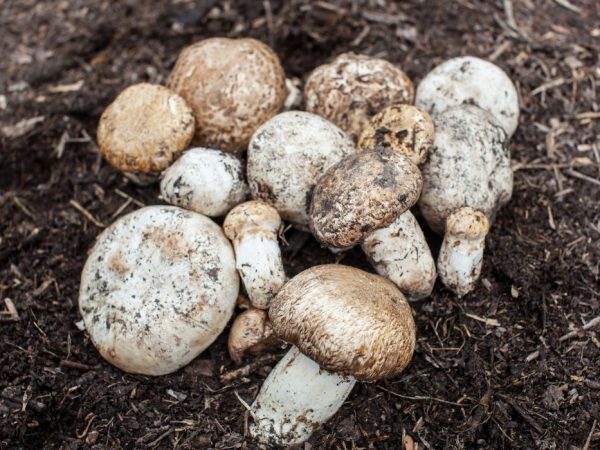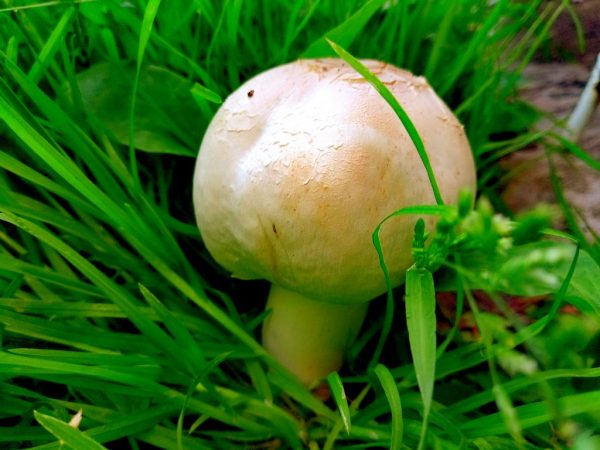Features of forest champignon
Forest champignon has excellent taste, pleasant aroma, which makes it attractive for culinary experts and delights lovers of "quiet hunting".

Features of forest champignon
Description
Agaricus silvaticus, cap, wolf mushroom and blagushka - these are the names of the forest mushroom from the Champignon family of the same name and the Champignon genus. Translated from French "agaricus" simply means "mushroom". It got its distribution in Great Britain, USA, Hungary and other European countries. In Russia, they learned about him after the 19th century.
Description of forest mushroom:
- cap size - up to 15 cm;
- the shape of the cap is ovoid or bell-shaped;
- the color of the cap is brown or brown;
- the plates are thin, light and frequent;
- leg - 15-20 cm in height;
- the structure of the leg is tubular, hollow;
- leg - 1-2 cm in cross section;
- the shape of the leg is cylindrical;
- a refined ring located at the top of the leg (very close to the cap);
- dense white flesh;
- characteristic mushroom aroma.
The hat changes shape and straightens out with age, becomes flat, with a slight bulge in the center. The old forest mushroom has a dark spot in the middle of a large cap that is cracked at the edges.
Mushroom pickers know that forest mushrooms turn red at the break, no juice is released from them, the pinkish plates gradually turn brown, with a purple tint. Such qualities are frightening for beginners - they do not take completely edible specimens.
The aroma of forest mushrooms is weak, mushroom, with a woody note. The variety is edible in any form; lovers of the delicacy eat it even raw.
Champignon belongs to saprophytes, grows on well-fertilized soil, near anthills (or on them) of red forest ant and lawns, in garden plots and park areas.
Irina Selyutina (Biologist):
As a species, the forest mushroom was described as early as 1762 by Jacob Christian Schaeffer - a German scientist, professor, who gave it the common Latin name in our time - "Agaricus sylvaticus". But for him there is also an alternative spelling in the species synonym - "silvaticus". These two spelling forms have the right to exist and are equally used by respected specialists from the world of mycology.
Fruiting in summer and autumn (July-October).
Views
The forest mushroom has several related inedible species, with which it is confused. The following similar species are characteristic of the false forest champignon:
- sh. flat-headed;
- sh. variegated, or w. Möller;
- sh. redhead, or w. yellow-skinned.
They grow in deciduous and mixed forests, in the same place as the edible species of forest mushroom, outwardly they almost do not differ.
The difference between edible and inedible mushrooms
False doubles are successfully camouflaged in parks and meadows, starting in July. They have some features that are important to focus on. Their description:
- less dense pulp;
- the leg on the fracture is poisonous yellow;
- the aroma is specific, medicinal.
When boiled, false mushrooms give the water a yellow tint. The smell of iodine and carbolic acid becomes evident. On the cut, the flesh acquires a pronounced orange color.
In some cases, forest mushrooms are confused with even more dangerous forest inhabitants: with pale toadstool and with white amanita. These are deadly poisonous mushrooms. In a toadstool, unlike champignons, the plates are whitish, with blueness. On the break, the pulp is colorless. At the base of the toadstool's leg is a saccular thickening - a volva.
Light fly agarics are similar in color to edible forest organisms. Their legs in the Volvo are like in a small pot; the plates do not change color with age.
When harvesting, it is important to carefully examine all specimens immediately on the spot and not put suspicious or unfamiliar ones in the basket.
Edible species

Eat only edible mushrooms
The genus Champignon (Agaricus) has several edible species that grow in nature. These include ordinary, field, meadow, Bernard, dark red, crooked, double-pore, etc.
- Champignon double-peeled: can be found in places where there is no grass or leaves on the ground. Its description:
- a hat with edges bent along the edge;
- hanging remnants of a private bedspread are visible on the edges of the cap;
- color from brown to white;
- juicy and dense pulp;
- young plates are pink, old ones are reddish-brown with a lilac tint;
- smooth cylinder-shaped leg.
Older individuals have light or whitish-brown legs. Its height reaches 10 cm and its diameter is up to 4-5 cm. There is a formation in the form of a ring under the cap.
- Champignon curve: the view is characterized by an uneven leg with a thickening downward. A medium-sized cap turns from an ovoid to a flat one with age. The pulp is underneath a thin beige skin. It has fibers, pale white. The plates are frequent and free; with age, they turn from white to black in color.
- Champignon dark red: direct relative of sh. ordinary (w. field). Outwardly, forest mushrooms are similar to him, but somewhat smaller. The scales in red look brighter and more noticeable. Young specimens are distinguished by pink plates.
Irina Selyutina (Biologist):
In the dark red champignon, there is a change in the color of the hymenophore plates in the adult state - they become brown-black. The color of the spore powder is slightly different - it is purple-brown. There is a thickening at the base of the stem, and at the stem itself there is a hanging brown, filmy wide ring. If you press on the leg, it will turn red. Likewise, the white, pleasantly smelling pulp changes color when cut. Intense red coloring of the flesh is a characteristic feature of this type of champignon.
- Bernard's champignon, or Agaricus bernardii: translated as "Bernard". It is an edible forest species. Possesses a pronounced aroma and taste. Its description:
- scaly surface of the cap;
- the size of the cap circumference - up to 15 cm;
- the height of the leg reaches 13-14 cm;
- the shape of the leg is cylindrical;
- plates are frequent;
- the pulp is clean and white;
- the ring is single-layer, thinned towards the edges.
A beautiful beige smooth hat, curved upwards, gradually becomes flat and cracked. It is fleshy and smooth. Bernard's champignon has a double - edible sh. two-ring, or w. sidewalk (Agaricus bitorquis), which has a double ring on the leg and a slight sour smell and taste.
Beneficial features
Forest mushrooms have a number of beneficial properties for humans. These mushrooms contain:
- vitamins A, P and PP, as well as group B;
- zinc;
- copper;
- manganese;
- ergosterol;
- amino acids;
- fiber;
- stearic acid;
- chitin.
They are able to support the body and activate its immune system. During viral outbreaks, they serve as a delicious natural barrier to viruses and bacteria.
Contraindications

Children are not allowed to eat mushrooms.
The forest product is difficult for the stomach to digest due to the high content of chitin, most of which falls on its legs.
People with gastrointestinal problems should not eat these mushrooms.
"Forest meat" is a kind of natural sponge that absorbs ions and salts of heavy metals, toxins from soil, groundwater and air. Specimens that grew near landfills, factories, highways or in urban areas should not be collected so as not to risk their health.
Children and the elderly are not allowed to enter the diet without the recommendation and advice of a doctor.
Application
Forest mushrooms are used in various fields: in medicine, pharmaceuticals, cosmetology, dietetics and cooking.
Cooking applications
Wild specimens are classified in category 1, i.e. they are certainly edible. These mushrooms are fragrant and nutritious. They are superior to fish in phosphorus content. Suitable for food in all forms: raw, fried, boiled, etc.
Chefs make a variety of side dishes from them. They are especially tasty when fried, with onions, in olive or sunflower oil.
Application in medicine and pharmaceuticals
Champignons are widely used to create preparations with bactericidal properties, ointments or tinctures. They are used to treat typhoid fever.
Folic acid increases the production of red blood cells in the red bone marrow and promotes metabolism. It has a positive effect on the functioning of the heart and blood vessels. In pregnant women, eating small amounts of champignons promotes fetal development and helps to form the placenta.
Amino acids, minerals and vitamins help to restore the energy balance, stimulate the human immune system.
A large amount of protein and antioxidants helps to lower blood sugar, so mushrooms are indicated for patients with diabetes mellitus.
In older people, they improve memory, stimulate the brain and increase concentration.
Application in dietetics
Champignons successfully combine high energy value and low calorie content. They contain more B vitamins than vegetables. Plant fiber and fiber give a quick feeling of fullness, so nutritionists prescribe this product as a dietary food for those who want to lose weight.
For those who play sports or go to the gym, the use of champignons helps to build muscle mass.
Conclusion
The forest harvest will bring not only pleasure, but also benefit if it is harvested, observing precautions, carefully sorting in place so that poisonous mushrooms do not end up in the finished dish or in a jar of pickles.



